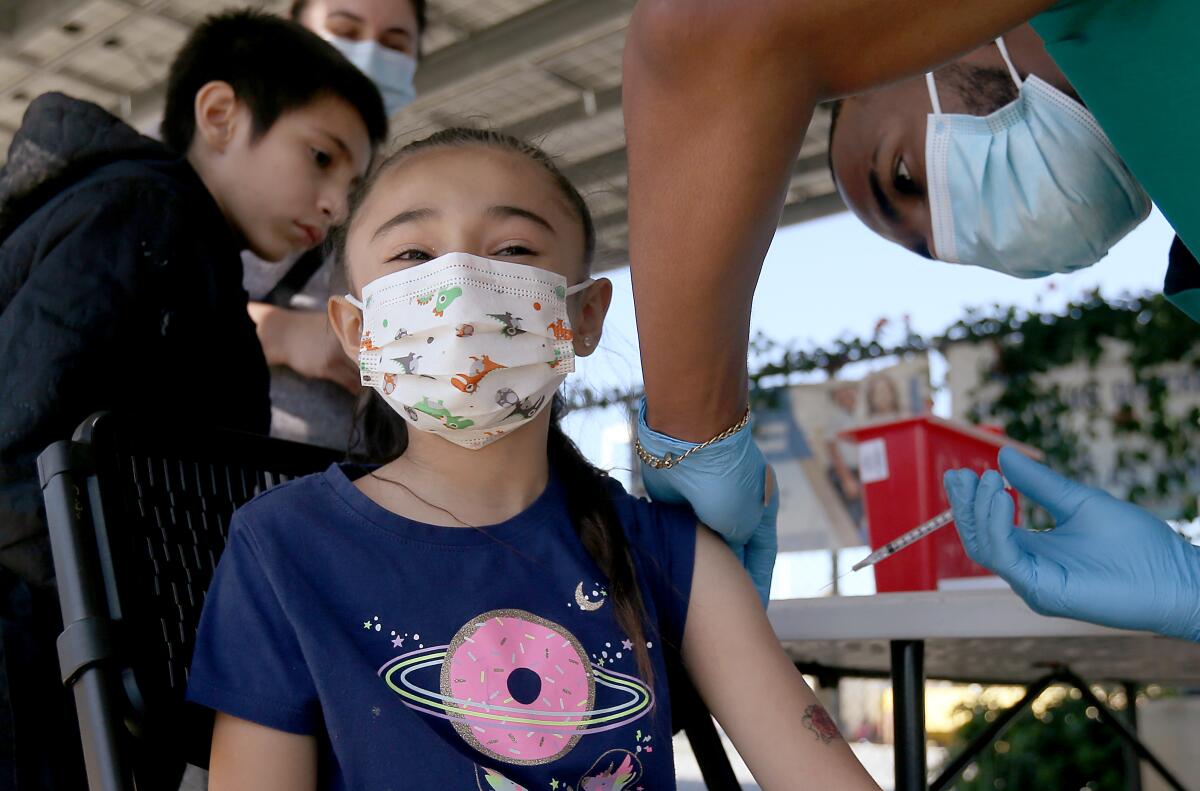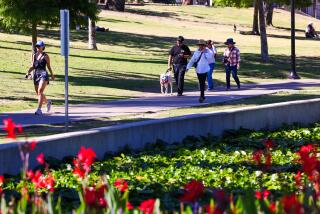Coronavirus cases are rising again in L.A., San Diego and San Francisco

- Share via
Coronavirus cases have begun to rise in Los Angeles, San Diego and San Francisco counties, likely a result of the highly contagious Omicron subvariant BA.2, decreased use of masks and waning immunity.
The increases are modest, and it’s unclear whether this is a brief hiccup, the beginning of a larger wave of cases or something in between.
“I think that it’s possible we might see a modest uptick in the next few weeks due to the fact that we are reducing some of the restrictions, such as indoor mask use,” UCLA epidemiologist Dr. Robert Kim-Farley said. “But I do not anticipate that we would see a major surge at this stage, just because so many people are immune, due to natural infection or vaccination.”
L.A. County has also observed an uptick in coronavirus outbreaks at K-12 schools: There were 10 last week — the most in a single week since mid-February — versus four the previous week.
The trends in some of California’s most populous areas echo what has been seen in parts of the East Coast, where a small wave has begun in New York and Massachusetts. BA.2 — which became dominant faster in the Northeast than on the West Coast — now comprises an estimated 72% of new weekly cases in the U.S., up from 57% the previous week.
While BA.2 accounts for 75% of cases in New England, New York and New Jersey, it accounts for 61% along the West Coast. Globally, 86% of new coronavirus cases over the past month were due to BA.2, according to the World Health Organization.
BA.2 is considered to be 30% to 60% more contagious than the earlier Omicron subvariant, BA.1.
In Western Europe, the new subvariant has had varied effects.
Britain endured a significant second Omicron wave that placed pressure on hospitals and caused the death rate to rise. The surge, fueled by BA.2, has brought weekly coronavirus cases to about 40% of the level from the first Omicron surge. Case rates now appear to be declining, UC San Francisco epidemiologist Dr. George Rutherford said at a campus meeting last week.
In Germany, Rutherford said, BA.2 has fueled “a true surge,” but one that’s regional, with many cases in the south of the country, including Bavaria, where vaccination levels are low.
Other nations, like Spain, seem to have avoided a second Omicron surge.
“I’m not so sure that what’s going to happen here in the United States as BA.2 becomes the dominant sublineage is all basically going to be doom and gloom,” Rutherford said. “There are good examples from Western Europe, where case rates have fallen in the face of the BA.2 outbreak.”
Other experts have expressed optimism about the latest data. The fact that BA.2’s dominance nationally has not caused a dramatic increase in cases is “encouraging,” Dr. Eric Topol, director of the Scripps Research Translational Institute in La Jolla, tweeted, although he cautioned that it’s still early in the subvariant’s rise.
“A more concerning development would be the emergence of a new variant, which is always the wild card,” said Kim-Farley, “which would render our immunity due to vaccines or infection less protective.”
California lately has been hovering around 2,800 cases a day, or about 50 a week for every 100,000 residents — on the edge between moderate and substantial transmission. The rate is higher than what was recorded before last summer’s Delta wave — fewer than 1,000 cases a day.
L.A. County reported 806 cases a day over the past week, up 16% from the prior week. The county is recording 56 cases a week for every 100,000 residents, meaning the rate is once again substantial.
L.A. County Public Health Director Barbara Ferrer described the increase as “a small uptick” and said that the best way to protect oneself is to get updated on vaccinations and booster shots and to wear masks in indoor public spaces.
Those age 50 and older, and those age 12 and up who are immunocompromised, were authorized last week to get a second booster shot.
“Encouragingly, the WHO did report that in countries with high levels of vaccination, especially among those that are most vulnerable to COVID, the recent increase in cases of COVID didn’t translate yet into high rates of hospitalization or death,” Ferrer said.
But she did express concerns about the rise in cases in the Northeast U.S., where “we’ve now seen an alarming 40% increase in cases this past week.”
She emphasized that the mortality risk remains high among those who are unvaccinated, particularly among the elderly. That has been observed in Hong Kong, which has a relatively low vaccination rate among its seniors and has run low on coffins.
There remain 1.7 million L.A. County residents age 5 and older who haven’t received a single COVID-19 vaccination dose. In early March, unvaccinated people were 11 times more likely to die from COVID-19 than those who were considered fully vaccinated.
The county also has 2.8 million vaccinated residents age 12 and up who haven’t received a booster shot; Ferrer called booster coverage “disappointingly low in some of our hardest-hit communities.”
Among areas with low booster rates are the Antelope Valley and parts of South Los Angeles, including Watts and unincorporated Florence-Firestone, Ferrer said. Booster rates countywide are lower among Black, Latino and Native American residents than among white and Asian American residents.
Ferrer urged people not to wait to get vaccinated and boosted, especially with Ramadan, Easter and Passover taking place this month.
“Given the threat of a more infectious variant circulating, this is really the time to get up to date on your vaccines,” Ferrer said. “Please don’t wait. Don’t wait until things get bad again before you put that mask on and be around a lot of other people — particularly other people who are at higher risk. Don’t wait to get boosted or vaccinated. Don’t wait to get tested.”
For people who do test positive, state health officials are saying that there is no longer a shortage of anti-COVID drugs in most locations.
“At this time, all outpatients with mild to moderate COVID-19 who are at risk for disease progression should be offered treatment, if eligible,” the California Department of Public Health said last week. People can seek prescriptions by calling their healthcare provider.
The U.S. government has launched a “Test to Treat” program, allowing people to get tested and get free anti-COVID pills at the same location, such as a pharmacy or clinic, as long as staff can either conduct a coronavirus test or evaluate an at-home test result and have on-site healthcare providers who can assess the patient.
A list of sites offering “Test to Treat” services in L.A. County can be found at ph.lacounty.gov/covidmedicines or by calling the county Department of Public Health at (833) 540-0473, between 8 a.m. and 8:30 p.m. seven days a week. They include certain CVS and Walgreens locations, as well as hospitals, clinics and local pharmacies. An L.A. County resident with a positive test can also get the drugs mailed to them at no cost by calling the same number.
For an L.A. County resident, “if you have an at-home test kit and you test yourself and you’re positive, you can call us. We’ll have a provider or a clinician talk with you, do an assessment. If you’re eligible, you will be sent that medication overnight so you’ll have it the very next day,” Ferrer said.
“Test to Treat” sites outside of L.A. County can be found at aspr.hhs.gov/TestToTreat.
The antiviral pills offered in the program are Paxlovid, manufactured by Pfizer, and molnupiravir, made by Merck & Co., which treat mild to moderate COVID-19. The drugs must be given within a certain number of days after symptoms begin, or from the day of a positive coronavirus test, and they work best if given early.
According to federal guidelines, Paxlovid and molnupiravir are recommended for patients “at high risk of progressing to severe COVID-19” but can be given only to those who are not so ill that they require hospitalization or supplemental oxygen treatment.
Elsewhere in California, Orange County is seeing a decline in cases — it’s now at 25 a week for every 100,000 residents, down from 27 the prior week. But if L.A. County continues to see increases, “there might be a possibility that we will see cases rise as well,” Dr. Regina Chinsio-Kwong, the Orange County health officer, said.
In San Diego County, the weekly case rate has risen to 83 from 58, according to state data.
San Francisco’s case rate is now 99, up from 93.
More to Read
Sign up for Essential California
The most important California stories and recommendations in your inbox every morning.
You may occasionally receive promotional content from the Los Angeles Times.











